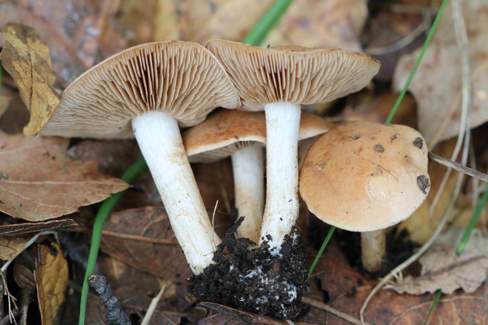 Hebeloma cohaerens (Photo: A. Montoya-Esquivel)
Hebeloma cohaerens (Photo: A. Montoya-Esquivel)Taxonomy
Full name: Hebeloma cohaerens A. Montoya & Beker, Mycokeys 90: 180 (2022)Genus: Hebeloma
Section: Theobromina
Types: MEXICO: Tlaxcala, Municipality of Panotla, 1 Km al Este de San Francisco Temezontla (approx. 19.3497°N, 98.2784°W, alt. approx. 2600 m a.s.l.) in coniferous, montane, subtropical woodland under Quercus sp., 23 Jul. 2017, A. Montoya-Esquivel (E3102) (Holotype. herbarium acc. no. TLXM 6156 (holotype), BR5020224875654V (isotype), HJB17733).
- arrow_drop_downarrow_drop_upEtymologyFrom cohaerens (adj. Latin) meaning united or joined together, to emphasize the connate habitus.
- arrow_drop_downarrow_drop_upDiagnosisThe short clavate-ventricose cheilocystidia, with average apical width less 6.5 μm, the small (on average less than 10 × 5.5 μm), weakly ornamented but rather strongly dextrinoid basidiospores and the whitish to cream or buff color of the pileus, differentiate this species from other Hebeloma species.
References
Description
- arrow_drop_downarrow_drop_upThresholds
Description of Hebeloma cohaerens based on 4 collections
- arrow_drop_downarrow_drop_upMacroscopic descriptionPileus: (22) 32–38 (47) mm diameter; shape convex, often applanate, occasionally umbonate or broadly umbonate; characters occasionally spotting; margin characters smooth, often involute, occasionally eroded; viscosity tacky when moist; colour variation unicolour; colour at centre usually cream, occasionally pale cream.
Lamellae: attachment often adnate or adnexed, occasionally emarginate; maximum depth up to 4 mm; number of complete lamellae 70–80; presence of tears absent; white fimbriate edge present.
Cortina presence: no.
Stipe: (31) 37–46 (48) x (5) 7–8 (10) {median} x (5) 7–10 (12) {basal} mm; stipe Q 4.5–6.6; base shape cylindrical, occasionally clavate; floccosity often pruinose, occasionally pruinose at apex; rooting no; thick rhizoids at base present;
Context: Texture firm; stipe interior stuffed; stipe flesh discolouring no; slenderness measure 6.0–6.9; smell earthy; taste Not recorded.
Spore deposit colour: Not recorded.
Exsiccata characters: Not recorded.
- arrow_drop_downarrow_drop_upMicroscopic descriptionSpores: shape amygdaloid, occasionally limoniform; colour in microscope yellow brown, often yellow; guttules yes. papilla often yes or weak; Spore Code: O1 O2; P0 (P1); D3.
Basidia: 22–27 x 5–7 μm; ave. Q 3.7–3.8; spore arrangement 4 spored;
Cheilocystidia: main shape clavate-lageniform or clavate-ventricose; special features observed often septa; cheilocystidia ratios: A/M = 1.49–1.63; A/B = 0.86–1.03; B/M = 1.59–1.88.
Pleurocystidia: none seen.
Ixocutis: epicutis thickness (measured from exsiccata) up to 110 μm; ixocutis hyphae width up to 6 μm; ixocutis hyphae encrustation no; shape of trama elements beneath subcutis cylindrical, often ellipsoid up to 14 μm wide.
Caulocystidia: Similar to cheilocystidia but larger, up to 90 μm.
- arrow_drop_downarrow_drop_upSpore measurements
- arrow_drop_downarrow_drop_upCheilocystidia measurements
- arrow_drop_downarrow_drop_upHabitat and distributionHebeloma cohaerens's preferred habitat appears to be montane, subtropical woodland. Where only one possible associate was recorded, the most commonly recorded associate was Quercus (75.0%) but Pseudotsuga (25.0%) were also recorded. In these cases the most commonly recorded families were Fagaceae (75.0%) and Pinaceae (25.0%). Overall the most commonly recorded families are Fagaceae (75.0%) and Pinaceae (25.0%) The growth habit of our collections was caespitose and often scattered.
According to our current collections, the species is found only in Northern America. On the continent, collections have been found only in the Trans-Mexican Volcanic Belt pine-oak forests WWF ecoregion The World Wildlife Fund (WWF) have divided the world into 867 terrestrial ecoregions. The ecoregion here is estimated by mapping from the GPS coordinates of the collection using data made available by Dinerstein et al (2017). Use this webtool to explore the ecoregions visually or see a full list of current ecoregions on Wikipedia. (tropical & subtropical coniferous forests biome). From collector information, it appears collections have been found only in the 1.9 Forest – Subtropical/tropical moist montane IUCN habitat We map from the collector's description of the habitat to the International Union for Conservation of Nature (IUCN)'s definition using a standardised set of rules. Please see this page for a full list of IUCN habitats.. Within Northern America all our records are from Mexico (Mexico).
- arrow_drop_downarrow_drop_upCommentaryThe small, short clavate-ventricose cheilocystidia, together with the small rather smooth, rather strongly dextrinoid basidiospores, support the placement of this species within Hebeloma sect. Theobromina. Within this section the pale cream to buff pileus color together with the caespitose habitus is unique. The description was based on just four collections all from the same region of Mexico, and is not known from any other location. More records for this species will help to define better its morphological characters and its biogeographic preferences. The minimum interspecific distance between the ITS sequences of H. cohaerens and sequences from other species is around 1.2%. The BLAST result of the type sequence of H. cohaerens against UNITE resulted in a hit of a soil sample sequence, pointing towards UNITE SH1563973.08FU (98.5% level). This SH includes two independently generated sequences from California (UDB0767851, soil sample, Tedersoo et al. 2021; DQ822802, basidiome, Point Reyes National Seashore Reserve, under Pinus muricata, Peay et al. 2007) that differ by around 0.5% from the sequences assigned to H. cohaerens, but match no other species. These results suggest that H. cohaerens may occur in the US (California) and the UNITE SH corresponding to H. cohaerens is likely to be SH1563973.08FU.
Geographic distribution
Phenology
- arrow_drop_downarrow_drop_upAdditional cited collections